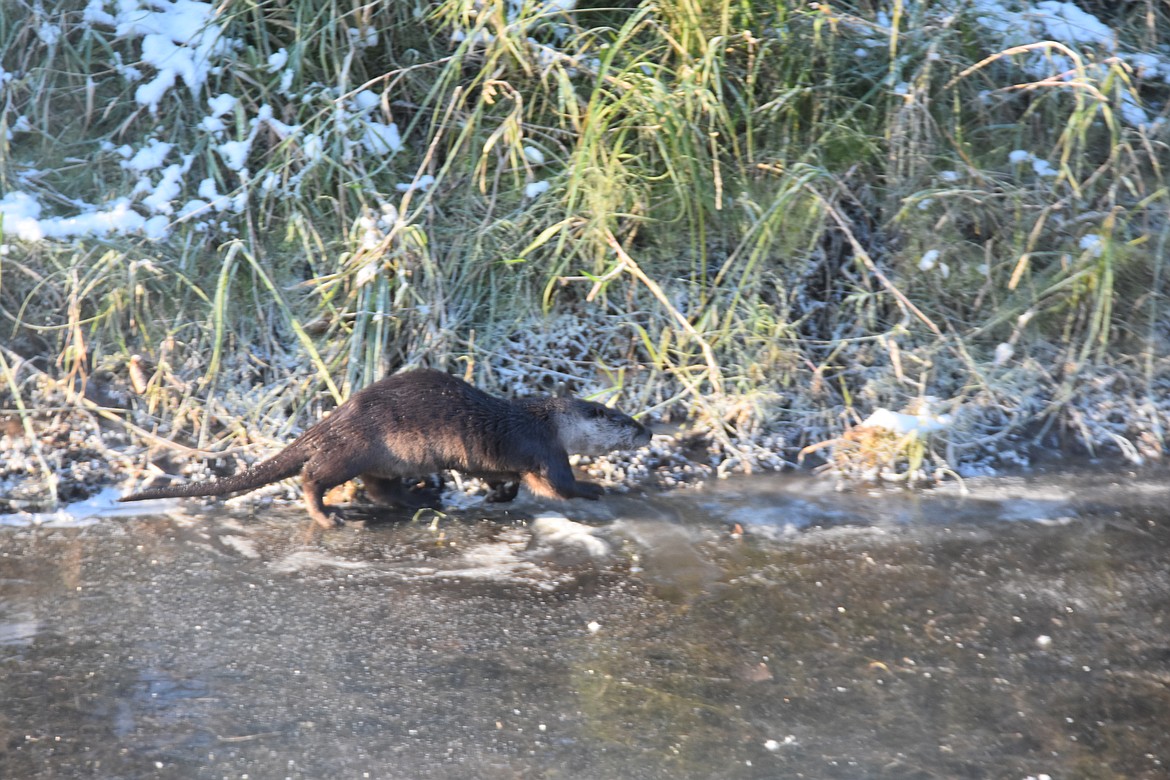River otters: playful and fast swimmers
It was just a flash of a furry animal with short brown hair and a long tail by the creek that got my attention. Upon further observation I saw it was an adult river otter. I grabbed my camera and the race was on.
The 30- to 36-inch (nose to tail) otter was running on the west side of Myrtle Creek and I was on the tour route road opposite him. In the process of his approximate ½ mile run, he never stopped to go in the water, which is their preferred environment. At the end of his run he stopped to roll in the snow in a shallow grassy area and then scampered over the hill to disappear at the edge of Cascade Pond. And all the time my camera was clicking away.
North American river otters, “Lontra canadensis,” are semi-aquatic mammals, with long, streamlined bodies, thick tapered tails, and short legs. They have wide, rounded heads, small ears, and nostrils that can be closed underwater. Their whiskers are long and thick.
The fur is dark brown to almost black above and a lighter color ventrally. The throat and cheeks are usually a golden brown. The fur is dense and soft, effectively insulating these animals in water. The feet have claws and are completely webbed. Body length ranges from 34 to 51 inches and tail length from 12 to 20 inches. Weight ranges from 14 to 30 pounds. Males average larger than females in all measurements.
North American river otters live throughout Canada and the United States, except for areas of southern California, New Mexico, and Texas, and the Mohave desert of Nevada and Colorado.
They are found anywhere there is a permanent food supply and easy access to water. They can live in freshwater and coastal marine habitats, including rivers, lakes, marshes, swamps, and estuaries. River otters can tolerate a variety of environments, including cold and warmer latitudes and high elevations.
Otters build dens in the burrows of other mammals, in natural hollows, such as under a log, or in river banks. Dens have underwater entrances and a tunnel leading to a nest chamber that is lined with leaves, grass, moss, bark, and hair.
Males and females come together to breed in late winter or early spring. Pregnancy lasts two months, but the young may be born up to a year after mating because these otters delay the implantation of the fertilized egg.
Births occur from November to May, with a peak in March and April. Females give birth to from 1 to 6 young per litter, with an average of 2 to 3, in a den near the water. They are born with fur, but are otherwise helpless. They open their eyes at one month of age and are weaned at about 3 months old. They begin to leave their mother's home range from 6 months to a year old. Sexual maturity is reached at 2 to 3 years of age.
North American river otters live alone or in family groups of, usually, females and their young. They are known as playful animals, often seen sliding in mud and snow and playing in the water. Many "play" activities actually serve a purpose. Some are used to strengthen social bonds, to practice hunting techniques, and to scent mark. North American river otters get their boundless energy from their very high metabolism, which also requires them to eat a great deal during the day.
They are excellent swimmers and divers, able to stay underwater for up to 8 minutes. They are also fast on land, capable of running at up to 18 miles per hour. These otters normally hunt at night, but can be seen at all times of day.
River otters communicate in a variety of ways. They vocalize with whistles, growls, chuckles, and screams. They also perceive their environment through vision, touch, smell, and hearing. Their large and abundant whiskers are very sensitive and are important in tactile sensation. These whiskers are used extensively in hunting, as smell, vision, and hearing are diminished in the water.
These river otters can live up to 21 years in captivity. They normally live about 8 to 9 years in the wild.
Enjoy Boundary County’s beauty and its amazing wildlife.



